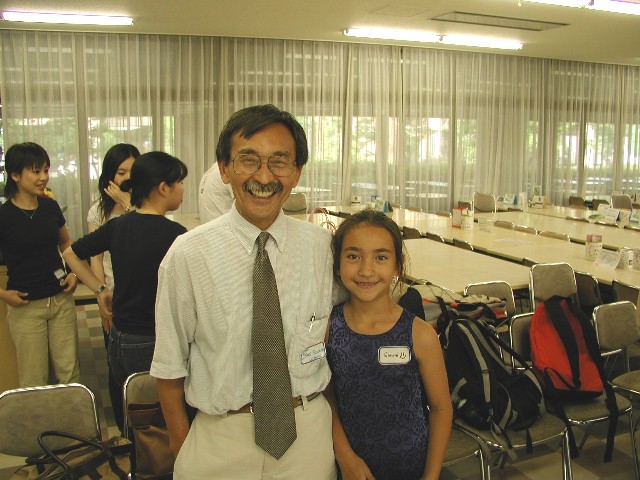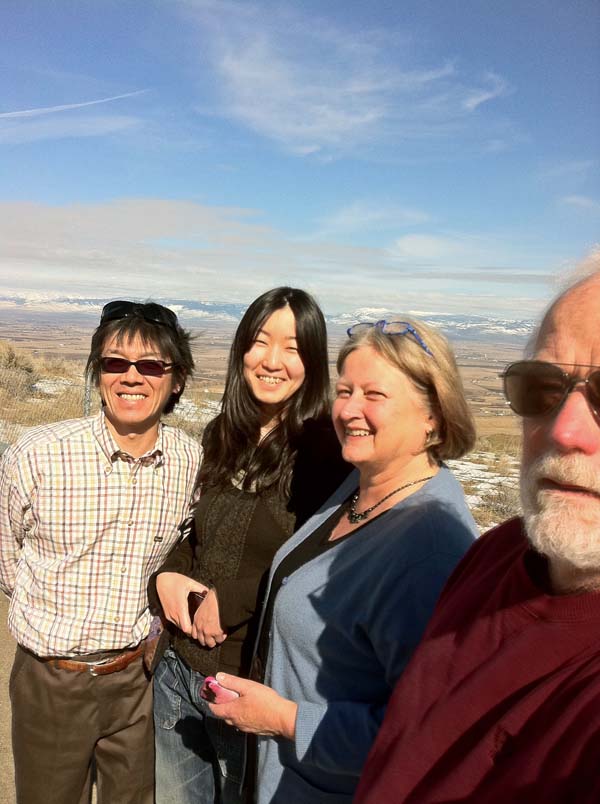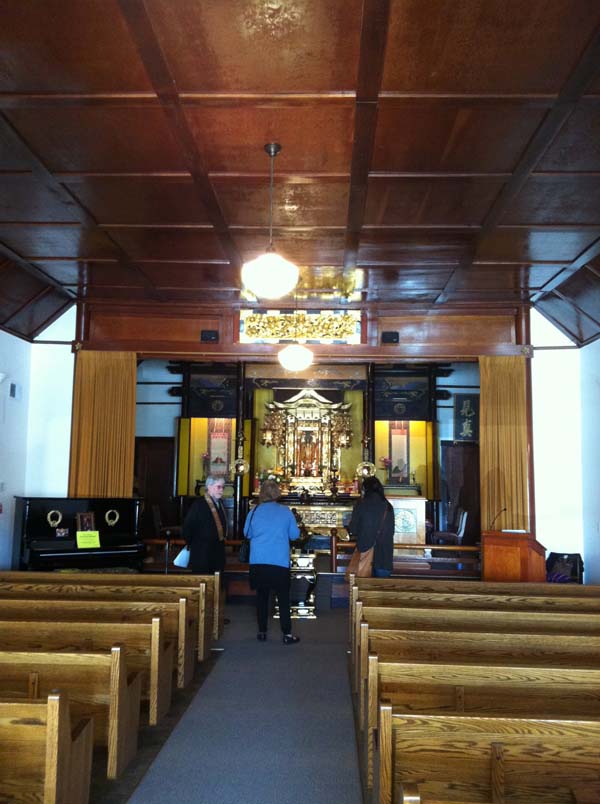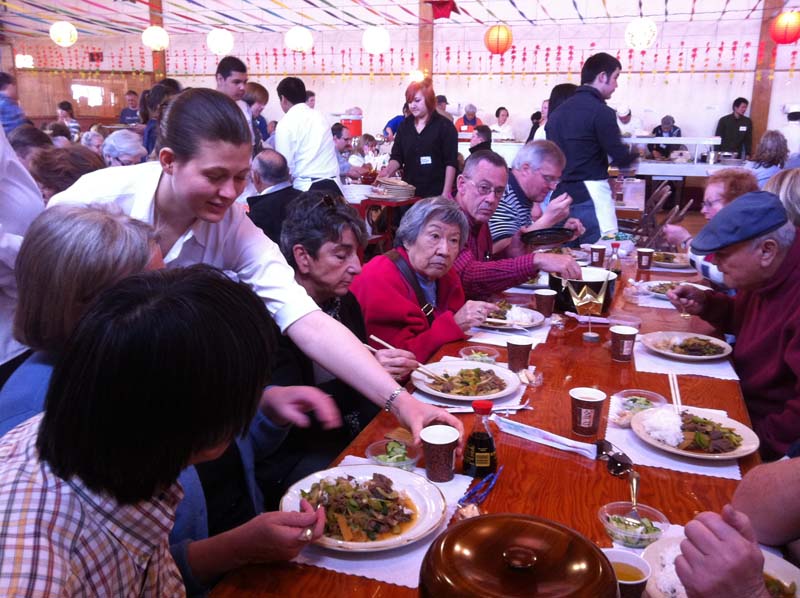
|
On Teaching and Building Community by Isao Fujimoto at the building naming ceremony for the Colleges at La Rue, UCDavis, Sunday, December 15, 2002
|
|
First of all I am glad to be alive to be here. My understanding of events such as this for naming buildings is that it occurs long after a person's journey on earth ends. There are two topics that are relevant to what we are doing here: teaching and community. Recently, I met with an incoming group of new teaching assistants. Our University, like many others, counts on a good number of our graduate students to assist in our teaching. Anyone who teaches, regardless of their rank or subject matter, can have great impact, positive or negative, on others. So to assess everyone's sense of the contributions teachers can make, I asked the several hundred people gathered for the workshop to answer one question: "Who was the best teacher you had and why?" This being a University audience which places a premium on knowledge and expertise, it was not surprising that best teachers were remembered with comments like "really knew his stuff; she wrote the definitive textbook; number one in his field" Others identified good technique as the mark of their best teacher: " always clear in explaining; best speaker I ever heard; had great examples and visuals that made everything easier to understand." But these accounted for only a third of the responses. What is it that defines a teacher besides being knowledgeable or having great teaching methods? The answer comes in these comments about teachers remembered-be they from elementary school, coaches, private music instructors, subject teachers in high school: "she said I was special; I was a slob but he never gave up on me; I was told I could be great but I needed to keep improving and he kept giving me challenging assignments; we were poor and my teacher bought the first suit I ever owned so I could be dressed like everyone else for my graduation." In other words, they were all about someone saying :"I care about you", providing that human connection which is critical for inspired learning to take place and for community to be built. It's a real privilege to be teaching at a place like UCDavis filled with bright,eager, energetic young people. But being among a lot of intelligent people, it's important for all of us to remember that being smart is not enough. There are a lot of smart people out there, up to no good. Look at the front page of this morning's paper and we'll see a half dozen stories- about smart people doing some pretty bad things - lying cheating, stealing, destroying people's lives. None of the stories are about people running the Mafia. They are stories about people running the church, corporations and governments .An important question for those of us with a roomful of smart,gifted students is not to be inquiring how gifted are you but to challenge each student to respond thoughtfully to "What are you going to do with your gifts? How can you use your gifts to build community no matter what you do, where you go?" So what is community? I saw a very good example of community growing up on the Yakima Indian reservation in eastern Washington State. Our family was on the reservation because of the Alien Land Laws which decreed that persons not eligible for citizenship could not own or lease land. Until 1952, no immigrant from Asia could become citizens of this country. The Alien Land Laws were specifically targeted against immigrants from Japan, the majority depending on farming for a livelihood. The Yakima Indians came through for us. There were 125 immigrant families from Japan leasing land and building a thriving community including a Buddhist temple in the reservation town of Wapato, Washington. As the families grew, there was a call to build a community center annex to the temple. My father, who was trained as a carpenter in Japan, was charged to supervise the project. We also had our farm but the demands of the building had him at the temple site all the time not just month to month but through the seasons from fall to winter to spring to summer. Our fields got neglected. It was hard to tell what we were growing for our fields were overrun with weeds. Then one day 50 farmers showed up and they swept through the carrot fields, harvesting, sacking , loading and shipping the crop off to the packing house . My parents were delighted and their thanks were met with the reply: "You've been doing a lot for us. Now it's our turn to do something for you." That is Community. Community is people caring for each other, coming together to work together to accomplish what no one person can do by oneself. Reaching out to each other with a sense of caring is the key ingredient in both teaching and building community. This is important for good learning to take place and for helping students to complete what they set out to do. Students drop out of school, not because they are not smart but oftentimes for facing stress too often in isolation, away from anyone caring, away from community. A good University may have a Nobel laureate or two. A great University builds community and smart and caring people. It's an honor to be included among all the people here who aim to make UCDavis a great University. __________ Footnote 2/13/11 Hi Jim, The Yakima Valley museum is in Yakima. John Baule is the museum director. The Yakima Indian nation museum is in Toppenish. The auditorium annex to the Buddhist temple in Wapato was built under the supervision of my father Taichi Fujimto. He was trained in Japan, which included serving an apprenticeship in the Imperial Palace. The auditorium was built by volunteer labor with farmers coming in every weekend up to the time of evacuation to the camps. My father's volunteer time continued throughout the year to the point that our crops could not be recognized for all the weeds. One day 50 farmers showed up and harvested a field of carrots - sacking, loading, shipping the harvest to the packer. My parents were very grateful and thanked everyone for their help. In response they said "You've been doing a lot for us. Now it's our turn to do something for you." That defined for me what is meant by community: "Community involves everyone working together to get something done that no one person can accomplish by themself". The former minister of the Buddhist temple, Tessho Matsumoto, had returned to Japan after WWII. When I was invited to speak at several conferences in 1988, I tracked him down and found him in the town of Uji, near Kyoto. We talked about the community working together to build the auditorium. He told me how they raised the funds in the middle of the depression. He and a young farmer named Spud Yamamoto went around the Yakima Valley informing everyone of the project and asking for contributions. Reverand Matsumoto spoke to Japanese families promising donors they would receive a scroll done by an esteemed calligrapher. When the appeal was made to non Japanese English speakers, Spud took over and announced that donors contributing $100 would be rewarded with a bottle of whiskey. Prohibition was still in effect so this went over big. My suggestion is to add to the building marker, the words "Built with Spirits". Isao ______________
from: John Baule
Dear Jim,
Yes, I do know Isao—a great fellow. His father was a skilled carpenter who apprenticed at the Imperial Palace in Tokyo before coming to this country. So when the Buddhist Community decided to build the Kaiken in the late 1930s, they asked Mr. Fujimoto to oversee and help in the construction. While he worked on the construction, his neighbors helped run his farm. I believe the date is 1939 (but don’t hold me to that) and it was largely finished when the all the Japanese on the Valley were evacuated in June 1942. The Kaiken is basically a large gymnasium with a stage at one end and classrooms for the Japanese language school or whatever the community needed. It is adjacent to the Buddhist Temple in Wapato and very much still in use and maintained—for example the Japanese Community holds a huge Sukiyaki Dinner there every March. I can make arrangements for you to see both the inside of this building as well as the Temple—just let me know when.
John
______________
On Mar 5, 2011, at 9:55 AM, Isao
Hi Jim,
If you can get to the local library today, see if there is a copy of Kazuo Ito's book Issei: A History of Japanese Immigrants in North America ..It's all about Japanese communities in Washington .It's a translation of the book written in Japanese titled Hyakunen Zakura (hundred years of cherry blossoms) epitomized by the stories of immigrants thusly:.' The Yakima valley was a desert that with water and sweat could be made to bloom. ..". If the library is out of reach today, your friends from Japan may be interested in tracking this down later..
Isao
______________
Date: Mon, 7 Mar 2011
Isao,
We all had a good time. Maybe I should say memorable.
I think the images and letters at John Baule's museum were disturbing and emotional to read, especially for our young Japanese friends. Nico Sasaki said she would "never forget" the experience. It launched Hiro-san into painful memories about his parents' divorce. And I am glad that we ate a good sukiyaki dinner and talked with so many nice people at the dinner, Japanese. Indian and Euro-American, before going to the museum.
Attached are some pictures I took. I tried to take notes but probably got some names wrong. We didn't meet any Hatas but we were told at least one of them was cooking.
Hiro, who's father was a famous carpenter in Takayama (see example) pronounced your father's work "excellent" - something he wouldn't say about our lovely boathouse in Port Townsend. We all were glad we went.
Yakima was a town with many examples of community cooperation. We learned of a fire which destroyed several Indian homes that were rebuilt by neighbors within weeks. I also liked the picture of the Filipino community hall out through the door of the Annex. Yet, in spite of the real sense of community, there was also evidence of great conflict in the newspaper articles at the time of the Japanese relocation and around Justice Douglas. Interesting place, Yakima. Thanks for sharing your compelling story which meant I had to go see for myself.
Best,
______________
3/20/11
Hi Jim,
Thanks for the photos and comments on your visit to the Yakima Valley Japanese community sukiyaki dinner, the Yakima Valley Museum and to the town of Wapato on the Yakima Indian reservation where I grew up.I'm glad you got to meet John Baule as well as various members of the Japanese American community
You covered a lot of ground coming all the way from Port Townsend through Seattle down to Yakima and Wapato. Seattle for us was a far away place and an important base of itinerant merchants who visited every Japanese farmstead on the reservation once a month. These included traveling sales people from various Japanese food stores that sent their panel trucks filled with Japanese food stuffs Another emissary was the movie man. There was something very unique about his talents that surprises people when they hear about this. He would accompany Japanese movies that were all silent prior to WWII. . The entire immigrant Japanese community would show up in the still to be completed auditorium .you visited for the sukiyaki dinner in Wapato.. Once he got the projector started , the movie man would go into action . He not only had memorized the entire script but he would project his voice to match the gender and age of whatever actor appeared. I had a student at UCDavis whose father was the last of these specialists who served the Sacramento and the California entral Valley Japanese immigrant communities prior to the coming of "talking' movies. ..These silent movie narrators are called "benshi" which can be Googled as such for additional lore.
Recently I gave a talk that references Wapato and the exhibit you saw at the Yakima Valley Museum.This was given as part of a Day of Remembrance event in Merced,California where the county fair ground was converted into a temporary concentration camp for Japanese Americans at the start of WWII. The Day of Remembrance refers to the day in February , 1942 when Franklin Roosevelt signed an executive order that initiated the imprisonment process.It identifies some key ideals that kept us focused on constructive activity, regardless of the negativity.I thought it would be worth sharing with friends who shared the Honduras experience such as our 1962 teams and people like Patty who is a member of the Yakima tribe and Charles Cox, active with the Quakers.
Cordially,
|

[Alice]
[Isao]
[Nancy]
[Jim]
[Joe]
[Susie]
[Bob]
[Grace]
Home


